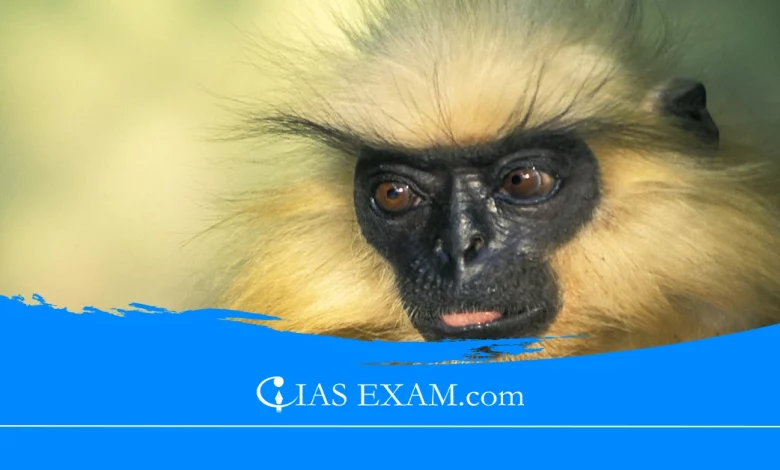Golden Langur Population in India: Survey Uncovers 7,396 Individuals
Syllabus: Environment and Conservation[GS Paper-3]

Context
According to a recent survey by the Primate Research Centre NE India, the Assam Forest Department has found that there are around 7,396 Golden Langur in India.
Golden Langur
About
- Golden Langurs (Trachypithecus geei) are an enchanting species of Old World monkeys found in the northeastern region of India.
- Renowned for their striking golden fur, these primates captivate the hearts of those who encounter them.
Physical Characteristics
- Golden Langurs are unique monkeys with yellow fur, long limbs, light-coloured skin, and bright eyes.
- They traverse arboreal havens with agility.
- Adult males often exhibit more body size and facial features compared to females, making them a good example.
Habitat
- The Golden Langur, a niche-generalist species, prefers various forested habitats in northeastern India, including Assam, Meghalaya, and West Bengal. These forests provide ample food resources and protection, making them suitable for their life.
Diet
- Gold Langurs are primarily folivorous, consuming foline from leaves, fruits, flowers, seeds, and insects.
- Seasonal food availability influences their dietary preferences, with fruits and flowers considered nutritious only during certain seasons.
Reproduction
- Golden Langurs have a unique breeding period throughout the year, with females giving birth to one baby after six weeks.
- Pregnancy can last longer, and the first young langurs receive nutrients and security from their mothers. Males defend their territory from external threats, including offspring attacks.
Conservation Status
- Golden Langurs are endangered by the International Union for Conservation of Nature (IUCN) due to loss of specialised habitats, fragmentation, and hunting.
- This endangerment is primarily caused by poor environments, human encroachment, and hunting for fur and body parts. Conservation projects aim to preserve wilderness areas and promote individual involvement.
Survey Methodology
- This poll intends to evaluate the precise, current population of Golden Langurs that is being distributed throughout India in the known habitat range.
- An affinity for statistical estimation for data analysis being blended with direct expeditions with infrared sensitive sensor cameras, one after the other, thus arrived at a good estimate. The same effort will increase the known protection areas which have a significant population of the langurs.
- Such places involve the establishment of national parks, wildlife sanctuaries, and forest reserves, among others.
Population Trends
- The collected data, interestingly, unravelled mostly causes for concern rather than humble echoes of hope.
- The data might be totally inspiring at the national level on total population, however at regions belonging to certain subpopulations the figure may be moving southwards. Major causes would be the damages of habitats and the push for human development.
- They show that there is need for constant checking and suitable actions in order to guarantee long-term preservation that these Golden Langurs are endangered.
Conservation Implications
- The current distribution map of Assam and Bhutan is, with all practical purposes, carried out as the central feature in the conservation plan of the golden langur in India.
- It helps to enumerate the gardening of policies, conservationists, and locals for suitable strategies, planning and implementations.
- Which in turn can encompass specific measures such as habitat restoration and protection, community-based conservation and wildlife poaching control approaches.
- The conservation of the species would also be favourably impacted if the significance of sustainability of these animals were promoted nationwide, similarly, community support.
Challenges and Opportunities
- Although a lot of progress has been made in terms of knowing and preserving Fast Golden Langur’s future further depends largely on our efforts.
- And these two factors are not the only ones contributing to the survival probability of language. Besides deforestation, infrastructure development, climate change, and others, this is also one of the reasons contributing to the risk of langur populations.
- However, such venues also provide opportunities for collaboration and innovations in conservation like conservation-based cooperative practices and technology-based warnings.
Conclusion
The survey revealing a population of 7,396 Golden Langurs in India represents a significant milestone for conservation efforts. While it provides cause for optimism, it also underscores the urgency of addressing ongoing threats to the species. By implementing targeted conservation actions, raising awareness, and fostering collaboration among stakeholders, we can work towards ensuring a secure future for Golden Langurs in their natural habitat. Continued monitoring and adaptive management will be essential to safeguarding this iconic species for generations to come.
Source: The Hindu
UPSC Prelims Practice Question
Q.Which of the following is a primary threat to the conservation of Golden Langurs in India?
a. Climate change
b. Habitat loss and fragmentation
c. Predation by larger carnivores
d. Pollution of water sources
Ans – “b”





.png)



